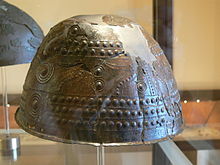Cap helmet
A cap helmet is a protective weapon that has been used in different versions in many countries.
description
A cap helmet is usually made of bronze . It was used by the Celts and Etruscans all over Europe and is usually named after the place where it was used or where it was found. It is a simple type of helmet that fits snugly to the shape of the head. The use of the cap helmets is around 1000 BC. Proven. They were used together with the comb helmets throughout the late Bronze Age and the early Iron Age and are related to the helmets of the urnfield culture and some helmets from the Hallstatt period . The dome is usually cup-shaped or hemispherical and usually has a leather inner lining. The helmet edges are flanged or kept smooth depending on the version. The shape, weight and decorations vary in the different versions. The helmet caps can be driven from one piece, driven in two parts and soldered or riveted, but they can also be made cast. There are cap helmets that are made with a crest, and those without any decoration. A Greek version has never been found on Greek territory, but various representations prove its former existence.
Versions
-
Iberoceltic cap helmet :
It is a version of the cap helmet from Spain, which was also used in other European countries. The helmet bell isdriven conically . It has two circumferential decorative lines that are double profiled. These lines are arched in the forehead and ear area and straight in the neck area. The helmet has cheek flaps and a narrow neck visor. In the helmet shown there are no longer any cheek flaps, but the holes for their attachment are visible. This type of helmet is very rare. -
Ebing cap helmet :
A German version of the helmet was excavated in the Main near Ebing . This cap helmet was made of two halves and flanged at the edges. -
Cap helmet from Thonberg :
Another helmet of this type, which was found in a hoard near Thonberg in the Kronach district , was cast . Today it is kept in the Germanic National Museum in Nuremberg.
Other cap helmets come from Hungary , today's repository at the National Museum Budapest, Greece , Persia , Italy ( Campania ).
literature
- Ortwin Gamber: Weapons and Armaments of Eurasia. Early times and antiquity (= library for friends of art and antiques. Vol. 51, ZDB -ID 518703-5 ). Klinkhardt & Biermann, Braunschweig 1978.
- Wolf-Dieter Heilmeyer : Early Olympic clay figures (= Olympic research 7). de Gruyter, Berlin 1972, ISBN 3-11-003962-1 .
- Wilfried Menghin : Celts, Romans and Teutons. Archeology and history (= library of the Germanisches Nationalmuseum Nürnberg on German art and cultural history. NF. Vol. 1). Prestel, Munich 1980, ISBN 3-7913-0522-0 .
Web links
- Photo of a version of the cap helmet at Hermann Historika, Munich
- Cap helmet from Thonberg at the Landscape Museum
Individual evidence
- ↑ Heilmeyer: Early Olympic clay figures. 1972, p. 62.
- ^ Website Hermann Historica, Munich, accessible online, (German, accessed on February 16, 2011) ( Memento from September 7, 2012 in the web archive archive.today ).
- ↑ Menghin: Celts, Romans and Teutons. 1980, p. 70.
- ↑ Menghin: Celts, Romans and Teutons. 1980, p. 95.
- ^ Gamber, Weapons and Armaments of Eurasia. 1978, p. 169.
- ^ Gamber: Weapons and Armaments of Eurasia. 1978, p. 407.
- ↑ Heilmeyer: Early Olympic clay figures. 1972, p. 62.
- ^ O. Blau : Two Mithridates of Armenia: I. Mithridates Kallinikos - II. Mithridates Philopator. In: Journal of Numismatics. Vol. 7, 1880, pp. 33-39, here p. 37.
- ↑ Bonn Yearbooks . Vol. 192, 1992, p. 581.


